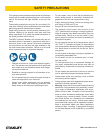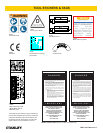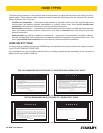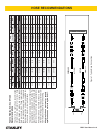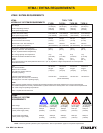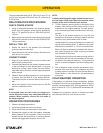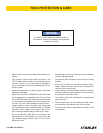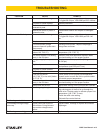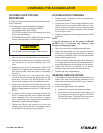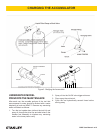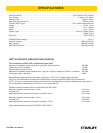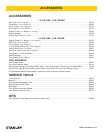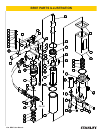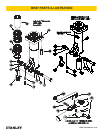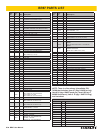
BR87 User Manual ◄ 13
PROBLEM CAUSE REMEDY
Tool does not run. Power unit not functioning. Check power unit for proper ow and pressure
(7–9 gpm/26–34 lpm, 1500-2000 psi/105–140 bar.
Couplers or hoses blocked. Remove restriction.
Pressure and return line hoses
reversed at ports.
Be sure hoses are connected to their proper ports.
Mechanical failure of piston or
automatic valve.
Disassemble breaker and inspect for damaged
parts.
Tool does not hit effectively. Power unit not functioning. Check power unit for proper ow and pressure
(7–9 gpm/26–34 lpm, 1500–2000 psi/105–140
bar.
Couplers or hoses blocked. Remove restriction.
Low accumulator charge
(pressure hose will pulse more
than normal).
Recharge accumulator. Replace diaphragm if
charge loss continues.
Fluid too hot
(above 140 °F/60 °C).
Provide cooler to maintain proper uid
temperature (130 °F/55 °C).
The collar support is not sliding
freely in the foot bore.
Remove, clean and replace as required. Make
sure hex bushing is in the proper location.
Tool operates slow. Low gpm supply from power
unit.
Check power unit for proper ow (7–9 gpm/
26–34 lpm).
High backpressure. Check hydraulic system for excessive
backpressure (over 250 psi/17 bar).
Couplers or hoses blocked. Remove restriction.
Orice plug blocked. Remove restriction.
Fluid too hot (above
140 °F/60 °C) or too cold (below
60 °F/16 °C).
Check power unit for proper uid temperature.
Bypass cooler to warm the uid or provide cooler
to maintain proper temperature.
The collar support is not sliding
freely in the foot bore.
Remove, clean and replace as required. Make
sure hex bushing is in the proper location.
Relief valve set too low. Adjust relief valve to 2100–2250 psi/145–155 bar.
Tool gets hot. Hot uid going through tool. Check power unit. Be sure ow rate is not too
high causing part of the uid to go through the
relief valve. Provide cooler to maintain proper uid
temperature (140 °F/60 °C max).
Check the relief valve setting.
Eliminate ow control devices.
Fluid leakage on tool bit. Lower piston seal failure. Replace seal.
Fluid leakage through charge
valve cap.
Upper piston seal failure or
accumulator O-ring failure or
accumulator charge loss or
failure.
Replace seals, recharge or replace accumulator
diaphragm.
Fluid leakage around trigger. Valve spool seal failure. Replace seals.
TROUBLESHOOTING



